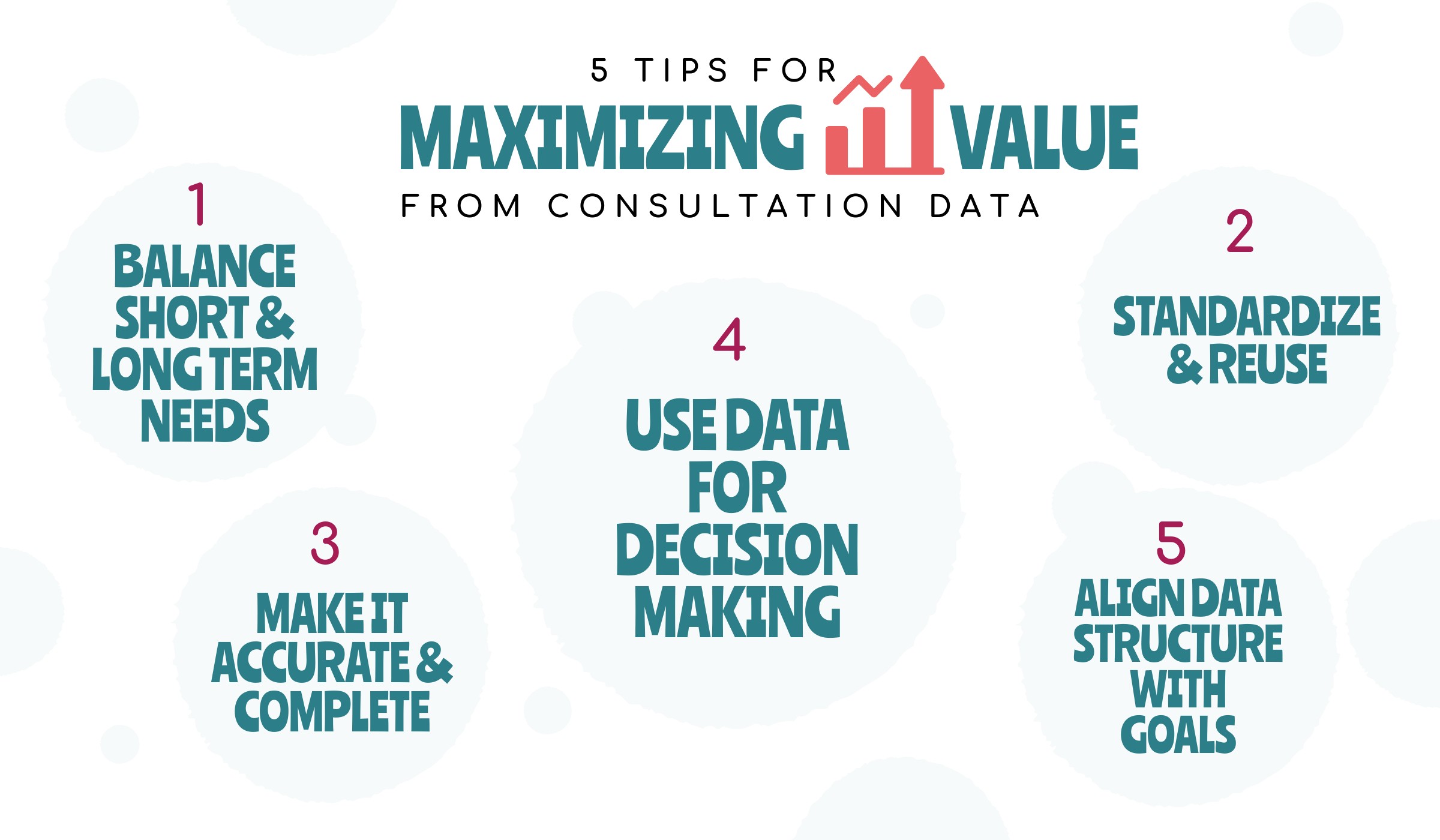How to Get More Value From Your Consultation Data

Do you put a value on your stakeholder and consultation data? If not, why not?
Consider this… you’re investing time and resources into collecting your engagement data and perhaps you’ve also invested in a stakeholder management system. Your stakeholder data should help you achieve your desired outcomes — and maybe even add real value to your organization’s bottom line.
This means that your stakeholder data is an asset that can deliver more value — as long as you manage it well.
The ‘data as an asset’ mindset is important because it can help you make better decisions on what data to capture, how to capture it, and how to make the best use of it.
Ready to start seeing your data as an asset and increase your ROI? We’ve got five tips to help you increase the value of your consultation data…
Five Tips to Maximize Engagement Data Value

1. Balance Short-Term and Long-Term Needs
To get the most from your engagement data, you need to balance both short-term needs and long-term objectives. But if you’re like most companies and collecting data on an ad-hoc, project-by-project basis, it’s very likely that you’re doing it purely with a short-term, “this project only” focus.
Perhaps you’ve engaged consultants to act on your behalf and they’re using a structure and system that best suits their needs to deliver the engagement process. The problem with this is that:
- It gives little consideration to the long term value in the data that is being captured
- Often this data isn’t even transferred to the client at the end of the project
- If the data is handed over, often the quality of data is virtually unusable
- Most organizations then end up treating the data as something to be archived once the project is finished
What that means is you’re putting in a lot of investment with no ongoing return. It’s a huge missed opportunity.
That’s why it’s so important to consider not just how the stakeholder data applies to the current project, but also what long-term goals and objectives the stakeholder data could align with for your organization, and how else it could add value.
For example, your organization will most likely need to report on its engagement activities across all operations at some point. And shouldn’t that information be captured (and reported on) across all projects? Even considering this simple objective will help to determine what data from your project is important and how that data should be captured to provide long-term value.
2. Standardize Data and Reuse It
One of the most obvious ways to get more value from your engagement data is to reuse it! Reusing your data can help you save time at the start of each new community engagement process because you never have to start from scratch. And it can help you improve your stakeholder experience, too. Because then you may not need to ask stakeholders the same questions the next time you engage with them.
So, how can you make it easy to reuse your data?
Quite simply, to effectively reuse stakeholder data, you need to standardize it. This involves using:
- Common terminology – Don’t use 100 different words for something, but use one word with a clear definition
- Standardized fields – Choose fields that you want to capture and report on across all your company’s operations
- Clear data structure – Clearly define your data management principles and protocols and ensure they’re maintained across each team and project
If you do this, with each new engagement, you will only need to make some adjustments to the standard structure. For example, adding in some additional fields specific to that consultation.
3. Check For Data Completeness and Accuracy
This might seem obvious, but achieving data completeness and accuracy across multiple teams, projects, and operations (especially over a long period of time) can be hugely challenging.
If you’re using spreadsheets or some other rudimentary method of recording stakeholder data, it can be especially problematic because:
- It’s time-consuming to keep that data up-to-date
- You have to ask around for each individual team member’s spreadsheet to determine which one is the most recent copy
- You have to consolidate records from multiple people to get a complete picture of your consultation
- It’s very easy for something to go missing
- People may forget to manually update information and add interactions
In a nutshell, spreadsheets are bad news for consultation data.
But this is where a good stakeholder management system like Simply Stakeholders can really come in handy. With all stakeholder records stored in one place (that all your teams can access, even across multiple projects), automations, integrations, and a clear data structure, it’s easy to keep your list of stakeholders and interactions up-to-date.
So, if you haven’t already implemented stakeholder software, this is one way you can almost certainly add value to your engagement data. Not just by improving accuracy and completeness, but by ensuring that data from your consultation process goes into an always-growing knowledge base that’s easily accessed by current and future teams.
To further expand on this point, consider making this a requirement of every new project. Include a data management plan that demonstrates how the project will:
- Use existing stakeholder data
- Update the data to meet the project needs
- Ensure that the rest of the organization will benefit from the updates
4. Embed Stakeholder Data Into Each Decision
Stakeholder consultation and engagement offers many potential benefits — better outcomes, saving time, reduced costs, and often delivering a competitive advantage. But the only way to enjoy these benefits is if you make the most of the data and insights you have access to.
So, embed your stakeholder data into your decision-making processes wherever possible. Not just on the current project, but on future projects and engagements, too.
For instance, if your reporting and evaluation measures regularly utilize data from your consultation projects, you will quickly identify any gaps and areas for improvement in your data. Learn more about this in our book on Stakeholder Engagement and Public Consultation Evaluation.
5. Update Data Structure to Align With Your Goals
Finally, it’s a good idea to regularly review and audit your data structure (we recommend once a year) to make sure it’s still aligned with your overall goals. Consider:
- Does it properly inform your evaluation and reporting requirements?
- Does it align to your KPIs and goals?
- How well are various teams and projects making use of the structure?
- Are teams refining and improving the structure?
- If teams aren’t using the data structure, is it because it’s not flexible enough for adapting to individual projects?
- Or are teams not using the data structures due to a lack of staff understanding or training?
It’s important to never assume that something that’s worked previously will continue to work indefinitely. So, this annual review offers a great opportunity to reflect on what your organization has achieved, as well as what you still need to do to ensure a consistent, high quality stakeholder engagement process — across all of your operations.
re what tool to use for managing your stakeholder data? Take a look at our info on the difference between a CRM vs SRM, Stakeholder Systems vs CRMs, and 5 Critical Features For Your Community Engagement Tool.
Learn More
Want to learn more about the value of stakeholder data or how to increase your ROI? Check out these related resources:
- 6 Ways Stakeholder Management Software Delivers ROI [Blog]
- 5 Simple Steps To Getting Started With Stakeholder Data Management [Blog]
- Evaluating Stakeholder Engagement and Public Consultation [eBook]
Or if you’d like to chat to our team about maximizing the value from your stakeholder or engagement data, we’d love to hear from you.






























